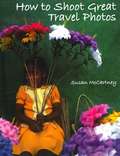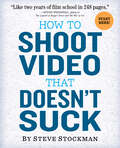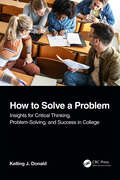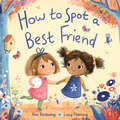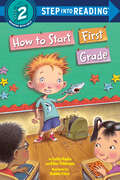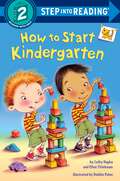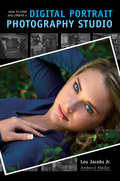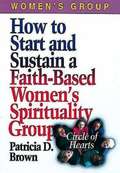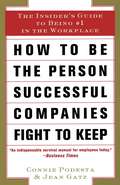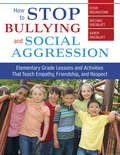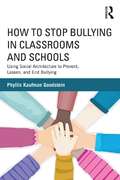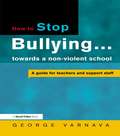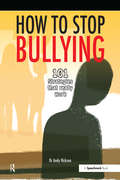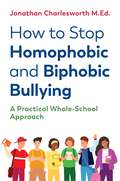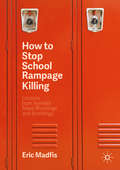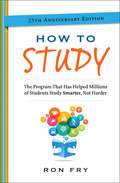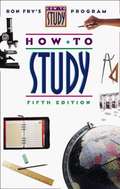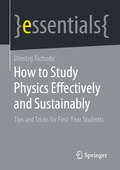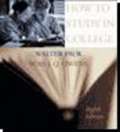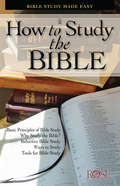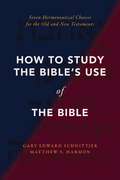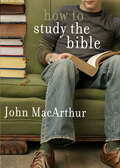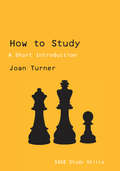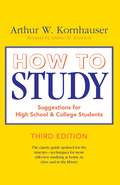- Table View
- List View
How to Shoot Great Travel Photos
by Susan MccartneySee the world--and bring it home in stunning travel photographs. * Authoritative advice on using the latest tech and travel trends * Make travel photography safer, more efficient, and less costly * More than 250 breathtaking photographs illustrate clear how-tos. See the world and capture original, top-notch images with How to Shoot Great Travel Photos--a book that's both a unique travel guide and a priceless photography book. Favorite author Susan McCartney, a world traveler and master photographer, explores all the angles: films, filters, and lightings under every exotic scenario; how to organize trips effectively; exposure and metering; and how to practice skills close to home, plus how to sell to the stock and editorial markets. Hundreds of stunning photographs illustrate every point, and tips on traveling safely, communicating with friends and clients from the road, and using the latest travel and photography equipment complete the picture. Whether readers want to create a beautiful scrapbook or a glossy corporate brochure, the world of travel photography is right at their fingertips.
How to Shoot Video That Doesn't Suck: Advice to Make Any Amateur Look Like a Pro
by Steve Stockman<P>Video is everywhere. Over 90 percent of American homes have some form of video camera, we upload 24 hours of video to the Web every minute, and we watch videos two billion times a day on YouTube. Problem is, most of it is bad—but here’s how to make it not only better, but also great. <P>How to Shoot Video That Doesn't Suck is all about the language of video. It’s about how to think like a director, regardless of equipment (amateurs think about the camera, pros think about communication). It’s about the rules developed over a century of movie-making—which workjust as well when shooting a two-year-old’s birthday party. <P> Written by Steve Stockman, the director of Two Weeks (2007), plus TV shows, music videos, and hundreds of commercials, How to Shoot Video That Doesn't Suck explains in 74 short, pithy, insightful chapters how to tell a story and entertain your audience. Here’s how to think in shots—how to move-point-shoot-stop-repeat, instead of planting yourself in one spot and pressing “Record” for five minutes. Why never to shoot until you see the whites of your subject’s eyes. Why to “zoom” with your feet and not the lens. How to create intrigue on camera. The book covers the basics of framing, lighting, sound (use an external mic), editing, special effects (turn them off), and gives specific advice on how to shoot a variety of specific situations: sporting events, parties and family gatherings, graduations and performances. Plus, how to make instructional and promotional videos, how to make a music video, how to capture stunts, and much more. <P>At the end of every chapter is a suggestion of how to immediately put what you learned into practice, so the next time you’re shooting you’ll have begun to master the skill. Accompanying the book is a website with video clips to illustrate different rules, techniques, and situations.
How to Solve A Problem: Insights for Critical Thinking, Problem-Solving, and Success in College
by Kelling J. DonaldThis concise and accessible resource offers new college students, especially those in science degree programs, guidance on engaging successfully with the classroom experience and skillfully tackling technical or scientific questions. The author provides insights on identifying, from the outset, individual markers for what success in college will look like for students, how to think about the engagement with professors as a partnership, and how to function effectively in that partnership toward achieving their pre-defined goals or markers of success. It is an ideal companion for science degree prospects and first-generation students seeking insight into the college experience. Offers transferable problem-solving ideas and skills applicable for other disciplines and future careers. Provides new students with support and inspiration for their college experience. Includes guidance for successful interactions with professors, peers, professionals, and others. Encourages thoughtful determination of desired outcomes from the college experience and shaping one's actions toward accomplishing those objectives.
How to Spot a Best Friend
by Bea BirdsongDo you know how to find a best friend? Find out in this wonderful celebration of kindness and friendship!"Today, I will find a best friend!" announces a little girl to her mother as they walk to school. Her mother reminds her that it's only the first day of school, and finding a best friend might take some time. But the girl isn't worried, because she knows exactly how to spot a best friend. "A friend lends you a crayon. A best friend lends you a brand-new, extra-sharp green crayon," she explains. And so begins a whimsical exploration of what it means to be a best friend. Full of imagination and charm, this is the perfect picture book for little ones hoping to find--and be--a best friend at school.
How to Start First Grade (Step into Reading)
by Ellen Titlebaum Ellen Vandenberg Catherine A. HapkaIt's back to school for Steve! Will his first day of first grade be ruined by the new kid? A hilarious Step 2 reader about self-confidence and friendship!Steve is so excited to start first grade with all his buddies from kindergarten! But then a new kid joins the class, and, boy, is she impressive! Hannah is from Alaska, and she's really cool. Even her show-and-tell is way more exciting than Steve's. But exaggerating to make himself seem cooler just lands Steve in the principal's office. Will he get into worse trouble, or can he maybe make a new friend? This book is a perfect follow-up to How to Start Kindergarten and a great choice for any kid getting ready to go back to school. Emergent readers will see themselves in this very relatable series. And when they're ready, they can read about the zany antics of Steve and his older brother, Will, in How Not to Start Third Grade, How Not to Babysit Your Brother, and How Not to Run for Class President (Step 3 books).Step 2 readers use basic vocabulary and short sentences to tell simple stories. They are perfect for children who recognize familiar words and can sound out new words with help.
How to Start Kindergarten (Step into Reading)
by Ellen Titlebaum Ellen Vandenberg Catherine A. HapkaA hilarious Step 2 reader about starting at a new school!David is the new kid at school, and is worried about fitting in. Steve is NOT worried about fitting in, and tells David, "Just do what I do and you will be great!" But when David listens a little too well, Steve has a bona fide copycat on his hands!Join the brothers from How Not to Start Third Grade, How Not to Babysit Your Brother, and How Not to Run for Class President for a new adventure...from younger brother Steve's perspective! Zany antics and plot twists will feel relatable and fun in this hilarious reader. Step 2 readers use basic vocabulary and short sentences to tell simple stories. They are perfect for children who recognize familiar words and can sound out new words with help.
How to Start and Operate a Digital Portrait Photography Studio
by Lou JacobsTwenty successful studio owners offer their expertise to aspiring professional photographers in this guide to operating a digital portrait studio. Every element of a thriving studio is covered, from choosing a location and determining a budget to selecting computer equipment and streamlining the digital work flow. Details on selecting backgrounds, sets, and props that set a studio apart and advice on lighting patterns, posing, and clothing selection help photographers ensure that they produce client-pleasing images and return customers. Customer service tips on creating comfortable waiting and viewing areas are included to help photographers set up an attractive space to better profit from their artistic skills.
How to Start and Sustain a Faith-Based Women's Spirituality Group: Circle of Hearts
by Patricia D. BrownThis book will be a resource for those who are interested in starting and sustaining a faith-based small group for women. It will include tools for organizing, creating, and sustaining the group, which the author calls a circle. The book invites women to develop their spiritual side, and to model their relationship with God as they envision ever-new ways to inspire, encourage, and affirm one another.
How to Stay Employed in Tough Times
by Connie PodestaAt a time of decreasing organizational loyalty and a decline in long-term job security, CEOs, managers, and human resources directors reveal on-target answers to the question on the minds of employees everywhere: What does my boss want? Based on a national survey of more than 300 people, this succinct guide provides real-life advice regarding job security today.
How to Stop Bullying and Social Aggression: Elementary Grade Lessons and Activities That Teach Empathy, Friendship, and Respect
by Steve Breakstone Michael Dreiblatt Karen DreiblattEncourage respectful, positive social behavior in all students! Providing educators with strategies for engaging bullies, victims, and bystanders at their own level, this user-friendly resource offers fun and meaningful interactive lessons and activities that support students’ safety and well-being, promote healthy social-emotional development, and improve academic achievement. This research-based book helps school districts meet the curriculum requirements of recently enacted bullying laws and includes: <p><p> Step-by-step guidelines for each activity <p> Sidebars, sample scripts, and icons that highlight important information <p> A supply list of common classroom items for quick and easy implementation <p> Suggestions for enhancing lessons
How to Stop Bullying in Classrooms and Schools: Using Social Architecture to Prevent, Lessen, and End Bullying
by Phyllis Kaufman GoodsteinThe premise of this guidebook for teacher educators, school professionals, and in-service and pre-service teachers is that bullying occurs because of breakdowns in relationships. The focus of the 10-point empirically researched anti-bullying program it presents is based on building and repairing relationships. Explaining how to use social architecture to erase bullying from classrooms, this book translates research into easily understandable language provides a step-by-step plan and the tools (classroom exercises, activities, practical strategies) to insure success in building classrooms where acceptance, inclusion, and respect reign examines the teacher’s role, classroom management, bystander intervention, friendship, peer support, empathy, incompatible activities, stopping incidents, and adult support from a relationship perspective If every teacher in every classroom learned to apply this book’s principles and suggestions, bullying would no longer plague our schools and educators could give 100 percent of their attention to academics.
How to Stop Bullying towards a non-violent school: A guide for teachers and support staff
by George VarnavaBy providing teachers with a practical intervention program to prevent bullying in their schools, this book gives the reader tried and tested strategies to tackle a very challenging problem. Creating a safe school environment where pupils feel secure is increasingly difficult, but this book shows how to devise a strategy, put it into practice, measure its effectiveness and extend the good practice into the wider community. The involvement of young people is a key element of this process. With its roots firmly in practice, the book is based on a study of' common characteristics of schools that have successfully reduced bullying; case studies that show how change can be achieved; raising whole-school awareness of the problem; how to tackle bullying as a whole-school issue; involving the students and the student council; delivering in-service training to colleagues. Primary and secondary school teachers, the school management team, learning mentors, teaching assistants and governors will find the guidance clear and suggested approaches helpful.
How to Stop Bullying: 101 Strategies That Really Work
by Andy HicksonThis book includes 101 tried-and-tested strategies to deal with bullying. This is a practical workbook full of information and ideas on how to stop being bullied. It contains 101 ideas grouped into five sections: practical and everyday ideas; longer term ideas; cyberbullying; fun ideas; and advanced techniques. In addition, there is information on creating and updating an anti-bullying policy, warm-up games and activities for groupwork, as well as stories of bullying and their resolutions. This is an extremely useful resource for people who get bullied, teachers, health care professionals and parents. Suitable for all ages. Andy Hickson is Director of Actionwork UK. Andy is a theatre Director and has had shows performed at the Globe, Sadlers Wells, Norwich Playhouse and many venues abroad. Andy specialises in using creative action methods to explore violence and other issues. Andy is also a filmmaker and was a runner-up in the 2008 Motorola film competition. Writing credits include Creative Action Methods in Groupwork which is translated into Polish and Japanese, and The Groupwork Manual (also published by Speechmark) and numerous articles and chapters. Andy is currently finishing off his PhD in education.
How to Stop Homophobic and Biphobic Bullying: A Practical Whole-School Approach
by Jonathan CharlesworthThis vital teachers' guide to challenging homophobic and biphobic bullying offers unique insights to address the issue at its core. With a renewed focus on a whole school approach, it builds capacity in those who work with young people and inspires an inclusive approach in every setting. Laying out clear advice on how to recognise, stop and prevent homophobic and biphobic bullying, readers are given strategies to work with its perpetrators, bystanders and targets. The author explains how to handle disclosures regarding sexual orientation and provides advice on effective Anti-Bullying Policy referencing homophobic and biphobic bullying. Based upon the work of the UK's leading and award-winning LGBT+ anti-bullying charity Educational Action Challenging Homophobia (EACH) this book additionally explores why young people are too often reluctant to report these forms of bullying; the increasing role of the online environment and the profound impacts bullying can have well into adulthood. Written by an expert in this field, this essential guide is for teachers, youth workers, the care sector and anyone with a duty of care towards young people.
How to Stop School Rampage Killing: Lessons from Averted Mass Shootings and Bombings
by Eric MadfisThis book tackles the important question of how we can understand and learn from the school rampage killings that have been prevented. In the flood of recent accounts and analyses of deadly school rampage killings that plague society and inspire widespread public fear, very little attention has been given to the incidents that almost were. Building on Madfis’ previous book, The Risk of School Rampage: Assessing and Preventing Threats of School Violence (2014), this vital work addresses key gaps in school violence scholarship through the examination of averted school rampage incidents in the United States and advances existing knowledge through ground-breaking insights from the latest research on mass murder, violence prevention, bystander intervention, disciplinary policy, and threat assessment in school contexts. This empirical study utilizes in-depth interviews conducted with school and police officials (administrators, counselors, security guards, police officers, and teachers) directly involved in averting potential school rampages to explore the processes by which threats are assessed and school rampage plots are thwarted. Madfis finds that many common contemporary school violence prevention policies and practices are ineffective at preventing rampage attacks and may actually increase the likelihood of their occurrence. Rather than uncritically adopting such problematic approaches, Madfis argues that schools must model prevention practices upon what has proven successful in averting potentially deadly incidents.
How to Study
by Ron FryThe bestselling How to Study (Seventh Edition) reveals the study skills that all students need to know in order to be successful, whether the goal is landing a top scholarship or excelling in school. This edition includes information on how to create an effective work environment, stand out in class, use the library, conduct research online, and much more. Plus, author Ron Fry covers all the traditional elements of a winning study strategy, such as reading, writing, time-management, memory, and test-taking skills. How to Study (Seventh Edition) introduces a revolutionary study system, along with examples, that gives students the edge in any learning environment.
How to Study (5th edition)
by Ron FryHow to Study has gained immense popularity among students of all ages for one simple reason: It works. Now updated and expanded for the information age, this "A-plus" read includes how to create a work environment, excel in class, use the library, do research online, and much more.
How to Study Physics Effectively and Sustainably: Tips and Tricks for First-Year Students (essentials)
by Dimitrij TschoduThe present essential contains a number of tips for the successful completion of physics studies. What makes it special is the inspiring style of the author, who studied physics himself and knows what he is talking about. Whether it's keeping lecture notes, working on exercise problems or effectively preparing for exams - this book motivates physics students even in difficult phases of their studies and encourages potential first-year students to dare to study natural sciences.This Springer essential is a translation of the original German 1st edition essentials, Wie man effektiv und nachhaltig Physik studiert by Dimitrij Tschodu, published by Springer Fachmedien Wiesbaden GmbH, part of Springer Nature in 2018. The translation was done with the help of artificial intelligence (machine translation by the service DeepL.com). A subsequent human revision was done primarily in terms of content, so that the book will read stylistically differently from a conventional translation. Springer Nature works continuously to further the development of tools for the production of books and on the related technologies to support the authors.
How to Study in College
by Walter Pauk Ross J. Q. Owens8th Edition: Our ultimate goal in this book is to provide you with tools, skills, and systems that will lead to self-sufficiency.
How to Study the Bible
by Rose PublishingWhether you are teaching people with no Bible experience or those who have studied the Bible for a long time, the best-selling How to Study the Bible ebook provides an excellent introduction to personal Bible study. This full-color ebook is ideal for teachers who want to provide information on studying the Bible in a quick, easy-to-use format. How to Study the Bible has concise steps for personal preparation, descriptive resources and reference information, and a step-by-step approach for inductive Bible study that teaches students to dig deeper into God's Word. How to Study the Bible shows how to approach Bible studies in an organized and life-touching way. This is Bible study made easy! The content is self-explanatory and is both easy to present and easy to use. Following the Bible study ebook you can learn how to explore the Bible, how to improve Bible skills, how to understand what the Scriptures means as a whole, as well as the Bible's real-life application on a personal level. How to Study the Bible encourages the pursuit of personal study and a deeper, more rewarding experience with God. How to Study the Bible presents these and many other important topics: •Why study the Bible •How to begin studying •Basic principles of Bible Study •Inductive Bible study •Basic Bible verses, passages and books of the Bible to study •Study tools and Bible reference resources like study Bibles •And the S.O.I.L. (four-step approach) that explains how to dig deeper into the Bible. Bible study leaders and teachers who use the How to Study the Bible ebook give students every opportunity to enjoy the lifelong adventure and spiritual discipline of Bible study. In addition to a systematic approach to studying the Bible, the ebook provides helpful instruction for personal growth and discovery that include: •The importance of keeping God's over-all plan in mind, the perspective of history and geography of Bible times, and the various forms of literature within the Bible •How to begin using inductive Bible study that asks, What does the Bible teach? rather than How do I prove my opinions by using the Bible? •Bible passages and topics to study •Applying the teachings of the Bible to everyday life •Key Scriptures to memorize. Those who use How to Study the Bible will develop the confidence to read and study God's Word on their own with a new passion. There's really not an easier way to teach others How to Study the Bible.Topical index: basic principles, Bible software, Bible studies, commentaries, concordances, how to study, inductive Bible study, key passages, life application, parables, passage study, poetry, principles of study, prophecy, studies for beginners, topical Bible
How to Study the Bible's Use of the Bible: Seven Hermeneutical Choices for the Old and New Testaments
by Matthew S. Harmon Gary Edward SchnittjerHow to Study the Bible's Use of the Bible: Seven Hermeneutical Choices for the Old and New Testaments by Gary Edward Schnittjer and Matthew S. Harmon is an essential resource aimed at teaching a hermeneutic for understanding the Bible's use of the Bible. Intended for students of both testaments, the book's innovative approach demonstrates how the Old Testament use of Scripture provides resources for the New Testament authors' use of Scripture. The authors provide students with a clear approach to handling the Bible's use of itself through seven key hermeneutical choices organized into individual chapters. Each chapter introduces a hermeneutical choice and then provides several examples of the Old Testament use of Old Testament and the New Testament use of Old Testament. The plentiful examples model for students the need to ground hermeneutics in biblical evidence and provide insight into understanding why the Bible's use of the Bible is important.
How to Study the Bible: How God Commissioned Unexpected People In The Bible And What He Wants To Do With You
by John MacArthurThe Bible is the Word of life. As such, studying the Bible is crucial to the life and growth of every believer. In this revised work, John MacArthur examines various Scripture passages in the Old and New Testament to answer both the &“why&” and the &“how&” questions of Bible study.How to Study the Bible can be used alongside or apart from the audio series available from Grace to You in either a personal or group study.UNIQUE FEATURES:Corresponds with the audio message series available from Grace to You Features revised content and study questions For personal or group study use
How to Study the Bible: How God Commissioned Unexpected People In The Bible And What He Wants To Do With You
by John MacArthurThe Bible is the Word of life. As such, studying the Bible is crucial to the life and growth of every believer. In this revised work, John MacArthur examines various Scripture passages in the Old and New Testament to answer both the &“why&” and the &“how&” questions of Bible study.How to Study the Bible can be used alongside or apart from the audio series available from Grace to You in either a personal or group study.UNIQUE FEATURES:Corresponds with the audio message series available from Grace to You Features revised content and study questions For personal or group study use
How to Study: A Short Introduction (SAGE Study Skills Series)
by Joan TurnerAny student can improve their learning in higher education if they want to, and the aim of this guide is to help you along this route, not by claiming there is only one right way to do things but by building awareness of different approaches, attitudes, and strategies. Key to this is the notion of active learning which is highlighted throughout the book with the acronym ASCERTAIN whose individual letters signal a range of different strategies and attitudes relevant in different contexts. Throughout, there is an awareness that among the different cultures students participate in, academic culture has its own set of values which academic staff tend to take for granted, but which students may need to have a greater awareness of, and build into your thinking and working. SAGE Study Skills are essential study guides for students of all levels. From how to write great essays and succeeding at university, to writing your undergraduate dissertation and doing postgraduate research, SAGE Study Skills help you get the best from your time at university. Visit the SAGE Study Skills website for tips, quizzes and videos on study success!
How to Study: Suggestions for High-School and College Students (Chicago Guides to Academic Life)
by Arthur W. KornhauserA complete guide for successful studying, How to Study is concise, practical, time-tested, and free of gimmicks. Designed originally for freshmen at the University of Chicago, this smart book has helped generations of students throughout the country improve their skills in learning quickly and effectively. It offers a no-nonsense plan of action filled with techniques, strategies, exercises, and advice for: *Mastering rather than just memorizing material *Learning the secrets of mental preparation before tackling difficult assignments or exams *Strengthening skills for better reading, note taking, and listening *Improving use of time in the classroom, the library, and at home It offers a wealth of advice, from the commonsensical ("Never begin study immediately after eating" and "Check every tendency to daydream") to the more psychological ("Use your knowledge by thinking, talking, and writing about the things you are learning"). Thoroughly revised and updated, this powerful little book can help any motivated and capable student work smarter, not just harder, from high school through college. When he wrote How to Study Arthur W. Kornhauser (1896-1990) was associate professor of business psychology at the University of Chicago.
